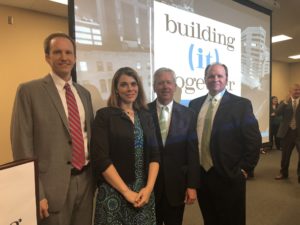 The Bold Goals Coalition of Central Alabama’s Workforce Action Network (“Network”) today released a major report and launched a public engagement campaign focused on aligning education, economic development and workforce development to increase job growth in the Greater Birmingham seven-county region*.
The Bold Goals Coalition of Central Alabama’s Workforce Action Network (“Network”) today released a major report and launched a public engagement campaign focused on aligning education, economic development and workforce development to increase job growth in the Greater Birmingham seven-county region*.
Throughout the summer, the Network will share findings from the report, “Building (it) Together: A Framework for Aligning Education and Jobs in Greater Birmingham,” and engage the public in interactive presentations on the findings.
The report was developed by Burning Glass Technologies and the Council for Adult and Experiential Learning (CAEL) and funded through the Bold Goals Coalition of Central Alabama. Building (it) Together’s lead partners include Alabama Possible, Birmingham Business Alliance (BBA)**, Central Six AlabamaWorks!**, Community Foundation of Greater Birmingham**, Innovate Birmingham, Jefferson State Community College, United Way of Central Alabama** and UAB**.
Jefferson State Community College, United Way of Central Alabama** and UAB**.

Birmingham is only the second region nationwide to commission such a report from Burning Glass, giving the region a unique opportunity to take data-driven steps to move Greater Birmingham forward. More than 125 local business and industry representatives participated in focus groups conducted by CAEL, providing direct feedback that helped to inform the report.
“A great deal of work already has been done to digest the research generated by Burning Glass and CAEL. While reviewing the findings, the Network made a commitment to share this information across the Birmingham region and developed a strategy to make it happen,” said Bill Jones, co-chair of the Bold Goals Education Coalition. “We need to make significant decisions about our future using this information, and we cannot make those decisions in silos. People across the seven-county region will be welcomed with open arms into this process, so we can truly build a transformational plan together.”
Key findings include:
- Employment in the Greater Birmingham region is projected to grow 8.9 percent over the next 10 years.
- Specific career fields that will experience supply gaps over the next 10 years include IT, business and financial operations, and architecture and engineering.
- The region experiences significant departures of skilled workforce talent – 43 percent of local college students and 53 percent of local doctoral students leave the region after graduation.
- Institutions of higher education are graduating students who can drive an innovation evolution within the region’s economy.
- Greater Birmingham is resilient, but falling behind other southeastern cities:
- The region has experienced a GDP growth rate of 8 percent since 2010. By comparison, surrounding metros reported double-digit growth.
- The region has experienced an employment growth rate of 6 percent since 2010. By comparison, surrounding metros reported growth more than double Birmingham’s rates.
- The region is lacking skilled and relevant workforce talent, and education and industry are misaligned. 78.5 percent of the region’s workforce is operating in low- or middle-skill positions. Future jobs will increasingly require relevant BA and Sub-BA degrees, so high school graduation rates must increase.
Key recommendations include:
- Support existing industry and leverage cluster-based approach to identify emerging companies and jobs, mainly in advanced manufacturing, life sciences and biotech, and IT.
- Focus on growth in non-local, exporting industries to encourage new wealth circulating in Birmingham.
- Invest in training related to targeted industries.
- Expand co-op and alternate training opportunities.
- Organize around recruitment of executive talent and support the risk taking necessary to change the local economy.
- Employers need to reconsider credential requirements.
- Strive for increased equity through nontraditional means, like IT boot camps.
- Increase high school and post-secondary education attainment.
Building (it) Together communicates the need and opportunity for collaborative decision-making between industry and education moving forward. “(it)” is a flexible element that signifies the varying assets that will help to strengthen Greater Birmingham’s future, whether that is (talent), (entrepreneurship), or (a strategic plan).
Network volunteers will coordinate region-wide community presentations on the findings to spur commitments to action. The presentations and conversations will take place throughout June, July and August 2018, and the insights gathered will inform a broader regional strategic action plan that will be used to implement recommendations. Community partners and stakeholders interested in hosting presentations on the findings can reach out the Bold Goals Workforce Action Network.
*The Greater Birmingham seven-county region includes Bibb County, Blount County, Chilton County, Jefferson County, Shelby County, St. Clair County and Walker County.
**Report funder
About the Bold Goals Coalition of Central Alabama
The Bold Goals Coalition of Central Alabama is a community-based initiative to align efforts aimed at addressing disparities in education, health and financial stability in the Central Alabama region. Impact-area workgroups are made up of key regional leaders from businesses, non-profits, government and education systems. These workgroups are committed to fostering change by examining root causes, establishing common, measurable goals and aligning current efforts.
The partners in the Bold Goals Coalition Workforce Action Network include Alabama Possible, Alabama Power, Birmingham Business Alliance, Central Six AlabamaWorks!, Community Foundation of Greater Birmingham, Jefferson State Community College, United Way of Central Alabama, and UAB.

